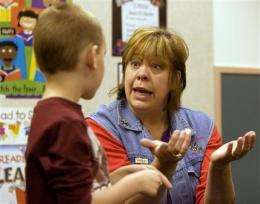School nurse shortage hampers swine flu response

(AP) -- As schools grapple with a resurgence of swine flu, many districts have few or no nurses to prevent or respond to outbreaks, leaving students more vulnerable to a virus that spreads easily in classrooms and takes a heavier toll on children and young adults.
The shortage of school nurses could lead to more students falling ill from the H1N1 virus, which can be particularly dangerous for children with weakened immune systems or respiratory conditions such as asthma, experts say.
"It's really irresponsible of the school district to not really provide medical oversight while kids are in school," said Jamie Hintzke, who has two kids in Northern California's Pleasanton Unified School District, including a son with severe food allergies. The district has one nurse for 15 schools and almost 15,000 students. "I'm playing Russian roulette every single day he goes to school."
When the swine flu emerged last spring, it was a school nurse in New York City - Mary Pappas at St. Francis Preparatory School - who helped identify and curtail the country's first major outbreak after she noticed large numbers of students complaining of high fevers and sore throats.
But many schools around the country don't have a medical professional who can quickly diagnose students and detect outbreaks.
A 2008 survey by the National Association of School Nurses found that only 45 percent of public schools have their own full-time nurse, another 30 percent have a part-time nurse, and a quarter don't have any nurses at all.
The average nurse-to-student ratio nationwide was one nurse for every 1,151 students, but in 14 states there was only one nurse for more than 2,000 students, according to the nurses association. States with the highest ratios include Oregon with one nurse for every 3,142 students, Michigan with one for every 4,204, and Utah with one for every 4,893.
Only 12 states, mostly in the Northeast, met the 1-to-750 ratio recommended by the Centers for Disease Control and Prevention, the association found.
In Michigan, severe financial problems prompted the Pontiac School District to lay off five of its six nurses, who played a key role in the district's response to swine flu last spring.
"If H1N1 is anything like the prediction, schools without school nurses will be missing their front line of defense," said Susan Zacharski, the district's only remaining nurse. She now works in a center for special needs students who are legally entitled to a nurse, but there are no nurses to serve the district's other 7,200 students.
With swine flu cases rising with the new school year, districts are depending on teachers, principals and secretaries with little medical training to identify, isolate and send home sick children, as well as monitor absences and illnesses for signs of a wider outbreak.
"We're asking so much more of untrained staff as far as providing medical management," said Nina Fekaris, a nurse in the Oregon's Beaverton School District who is responsible for four schools with 4,300 students. "It's putting our kids at risk."
Some teachers complain they haven't received guidance or training on how to deal with swine flu.
"We really don't know what symptoms to look for, how to caution our kids or how to protect ourselves," said Robert Ellis, a first grade teacher at Washington Elementary School in Richmond, Calif. "I'm really concerned about it spreading in the classroom, how many kids will be impacted and the loss of educational time."
Since it was first identified in April, the swine flu has infected more than 1 million Americans and killed nearly 600, the CDC estimates.
So far swine flu does not appear to be more dangerous than seasonal flu, which kills an estimated 36,000 Americans each year, but it appears to be more contagious and health officials are concerned that it could mutate and become deadlier.
Federal health officials are urging parents to have their kids vaccinated, but the H1N1 vaccine will not be ready until October.
In districts that have them, school nurses are developing plans to screen and quarantine sick students, teaching students proper classroom hygiene, urging parents to keep ill children at home, organizing vaccination campaigns and instructing teachers and school staff how to identify sick students.
In Utah's Granite School District near Salt Lake City, officials have prepared a pandemic response plan, but the district only has 10 nurses for 89 schools with 68,000 students.
"It would be great to have a school nurse in each school. Unfortunately, we don't have that luxury," said district spokesman Ben Horsley.
In California, where there was one nurse for every 2,240 students last year, roughly half of the state's 1,000 school districts do not have any nurses at all.
Among them is the Berkeley Unified School District, which has 17 schools with 9,000 students. The district has a partnership with the city health department to deal with school health issues, but has not had its own nurses for many years, said spokesman Mark Coplan.
"Parents have called to say, 'Is there a new policy to deal with H1N1? We say, 'No, it's exactly the same as seasonal flu,'" Coplan said. "We really want to treat this as a normal situation."
Only 19 states require certain nurse-to-student ratios, and few states set money aside to pay for nurses, according to the nurses association.
Brenda Green, director of school health programs for the National School Boards Association, is urging school districts without nurses to partner with local health agencies, hospitals and nursing schools to prepare for swine flu.
"What I'm concerned about is anyone thinking this won't happen here," Green said. "If there's no plan in place, and people just acting in an ad hoc way, that's risky."
©2009 The Associated Press. All rights reserved. This material may not be published, broadcast, rewritten or redistributed.




















